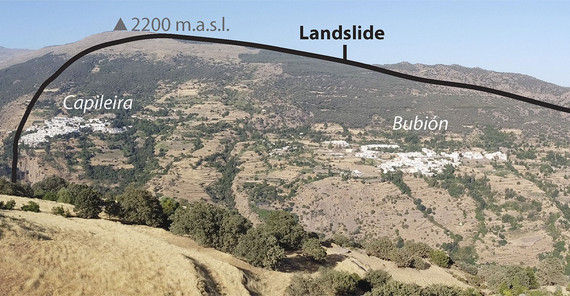The IPCC’s 2022 Assessment Report indicates that people will be more vulnerable to the impact of natural hazards exacerbated by climate change in the future. This is especially relevant to a rising population of 1.28 billion in mountains, because up to 40% of this population has migrated to cities amid steeper hillslopes more prone to landslides. On these slopes, slow-moving landslides can occur that may seem inconspicuous and safe to settle on. They can accelerate suddenly and necessitate evacuation or abandonment, given risk of mass fatalities in a matter of minutes with a rapid collapse. “Yet, we have no global overview nor estimate of the current exposure of settlements established on unstable slopes,” says Joaquin Vicente Ferrer, PhD student at the University of Potsdam and leading author of the study.
For a near-global assessment of exposure the authors compiled a new database of 7,764 large slow-moving landslides with areas of at least 0.1 km² each, bringing together data, inventories, and knowledge from various sources. Using this database, they explored regional and global drivers of exposure using statistical models. They found that urbanization can be a relevant driver, while steepness and flood exposure have regionally varying influences. “Our study provides the first global estimation of slow-moving landslide exposure,” summarizes Joaquin Vicente Ferrer. “With our methods, we quantify the underlying uncertainties amid disparate levels of monitoring and accessible landslide knowledge.”
The work published in the journal “Earth’s Future” aims to connect disaster risk management and climate change adaptation research communities. The intertwined risks of landslides and flooding in changing basins must be managed jointly in order to prevent migration and expansion onto unstable slopes.
Link to Publication: Ferrer, J. V., Samprogna Mohor, G., Dewitte, O., Pánek, T., Reyes‐Carmona, C., Handwerger, A. L., et al. (2024). Human settlement pressure drives slow-moving landslide exposure. Earth's Future, 12, e2024EF004830. https://doi.org/10.1029/2024EF004830
Image: Villages on a slow-moving landslide in the Poqueira Valley, Spain. Image Credit: Cristina Reyes Carmona
Contact:
M.Sc. Joaquin Vicente Ferrer, Institute of Environmental Science and Geography
Tel.: +49 331 977-6257
E-Mail: ferreruuni-potsdampde
Media Information 18-09-2024 / Nr. 086

